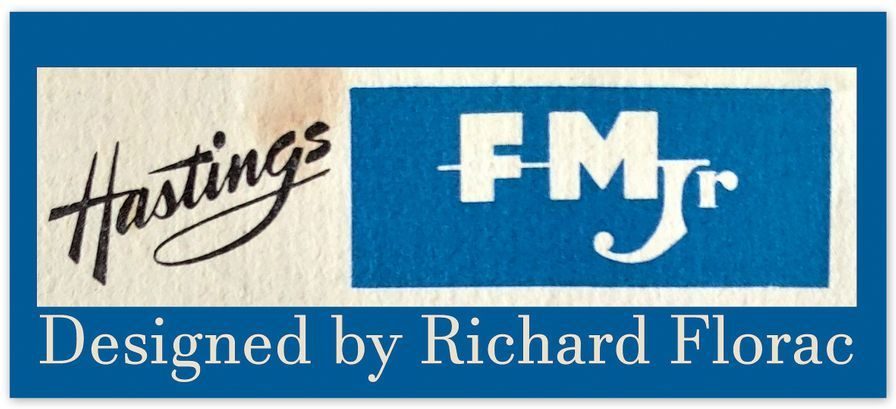
«High Fidelity in the palm of your hand»
«Ounce for ounce the most remarkable radio ever produced»…. Or so the brochure says…. In many ways this little ‘FM only’ radio was way ahead of its time and in many ways it was not…. Read on!
The Hastings FM Jr was manufactured by Hastings Products Inc of Boston, Massachusetts circa 1955. It was first released onto the market in 1954 under the brand name ‘Florac’. Designed by Richard Florac (1901 — 1991) it may very well be the world’s first commercially available shirt pocket FM radio. I will present my argument for this further down the page. The FM Jr does not use transistors, it uses two subminiature tubes manufactured by Raytheon.
The advertisement to the right for the Florac (Hastings FM Jr) appeared in the Chicago Tribune on the 8th of November 1954. It was being sold for $29.95 by legendary sporting goods store Von Lengerke & Antoine, commonly known as the Chicago branch of Abercrombie & Fitch.
The FM Jr can trace its design roots back to the 1950 Florac pager (patented 1952); the worlds first radio pager designed for Aircall Inc. First used by Doctors, the pager needed to be checked every hour by holding it up to your ear and listening for your personal code (along with everyone else’s!). If you heard your code then you had to get to the nearest phone and call the answering service to hear your message (Ref 1a).
You can see the aluminium cased Florac pager below. It is quite similar in appearance to the FM Jr and even more so on the other side where it has a large metal button off-centre….
In 1953, inventor Richard Florac started ‘Ultra Miniature Electronics’, a business based in Long Island, New York. Drawing on his previous experience developing the Florac Pager he has modified the design, added an earphone and started manufacturing the Florac shirt pocket FM radio, releasing it in 1954. During this period he was joined by electronics engineer and entrepreneur T. Mitchell Hastings Jr who agreed to finance and manufacture Florac’s little radio. It was subsequently rebranded as the Hastings FM Jr.
T. Mitchell Hastings Jr was an FM radio pioneer; in 1954 he developed America’s first FM car radio with aid from electronics experts at the Massachusetts Institute of Technology. It was available to purchase for $149.00 (Ref 1b). In 1957 he purchased the FM Concert Network comprising of four stations in Hartford, Providence, New York and Lexington (Ref 1c). Hastings was known as being a bit eccentric; it is said that he regularly visited clairvoyant Edgar Cayce and sat with the famous seer to gain glimpses into the future. Some of these predictions may have formed the basis of Hastings’ shaky business decisions. Eventually, a financial crisis at Concert Network forced him to sell off his radio properties until only WBCN remained.
To the right — Theodore Mitchell Hastings Junior (1910 — 1994).
Following is an excerpt from a 1966 interview with Hastings regarding the FM Jr (Ref 1d):
Hastings: «I spent somewhere in excess of $50,000 on my automobile radio project. And probably another $25,000 on this little FM vest pocket set. I wanted to prove that you could build a very small, inexpensive, but quite workable FM vest pocket receiver».
Interviewer: «Is this on the market?»
Hastings: «This happens to be… No, it’s not on the market. I just happen to have sold a few thousand of them, and then I stopped the production of these sets when I went into broadcasting».
Interviewer: «Don’t tell me you build them and then give them away as presents?»…
Hastings: «No, no, not quite but almost. I really was wrapping up a $10 bill in each one of them even charging what I was charging for them».
There are a couple of important takeaways from this short interview. Firstly Hastings makes no mention of the FM Jr being designed by Richard Florac, in fact he doesn’t mention Florac at all. Clearly Florac was very proud of his invention as it states that he designed the radio on the gift box, in attached literature and even inside the radio itself! I imagine that Florac specified these terms in order to protect his intellectual property rights and prevent Hastings from laying claim to his invention. Of note, I have seen several articles where Hastings is named as the inventor of this radio, probably due to having his name on it and his earlier development of the FM car stereo.
To the left is the cover of the extensive 12 page instruction manual that includes everything from how to wear your earphone to the advantages of FM.
Secondly, Hastings states that only a few thousand were sold and if this is true then that would probably be why the FM Jr is so difficult to find in modern times. In comparison, it is believed that the Regency TR-1 had a production run of approximately 100,000 during the same period. It would be interesting to know exactly how many of these rare little radios are now in the hands of collectors.
So why was the FM Jr a commercial flop? Author and Archaeologist Michael Brian Schiffer argues that the FM Jr was marketed at a time when AM radio was king. Rock n Roll was just taking off and its popularity on AM stations went hand in hand with the new transistor portable revolution. Schiffer states — «Though cheap (21.95 with batteries), the Hastings FM Jr was a flop — not because it was a mediocre performer but because it was FM only. In 1958 (Schiffer got the FM Jr release date wrong) FM was for highbrows; listening to classical music through an earphone was unthinkable. Not until the late sixties would rock n roll be heard on an FM station» (Ref 1e).
Undoubtedly the FM Jr also suffered from the negative public perception that affected the earlier Privat-Ear and Belmont Boulevard. The wearing of an earphone at this time conveyed an image of infirmity due to its association with hearing aids that used the same type of earplug. Schiffer states — «How many middle aged adults would have been eager to embrace an artifice that seemingly proclaimed «My body is wearing out». In addition, earplugs — one size fits all — were not that comfortable and frequently slipped out of the ear» (Ref 1f).
As you can see from the photo above, the FM Jr was available with an optional second earphone for true high fidelity reproduction. The second earphone came with a simple pin adapter to allow it to be used with the current single earphone. The instruction manual recommends wearing each earphone cord over the ear — like modern sports earphones. This was a look that was years ahead of its time and wouldn’t become popular until the early 2000’s.
Clearly, at this time the average consumer was not ready for the Hastings FM Jr and although it probably worked ok the principle technology used (subminiature tubes) was outdated — or was certainly about to be!
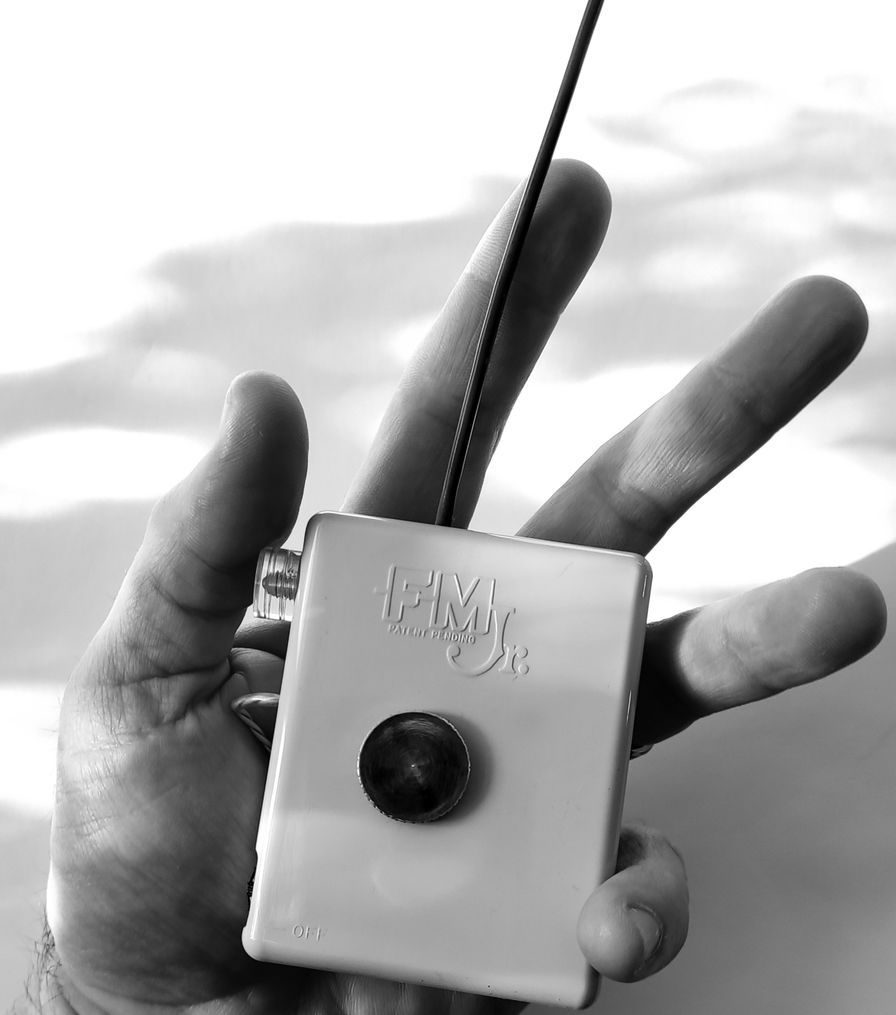
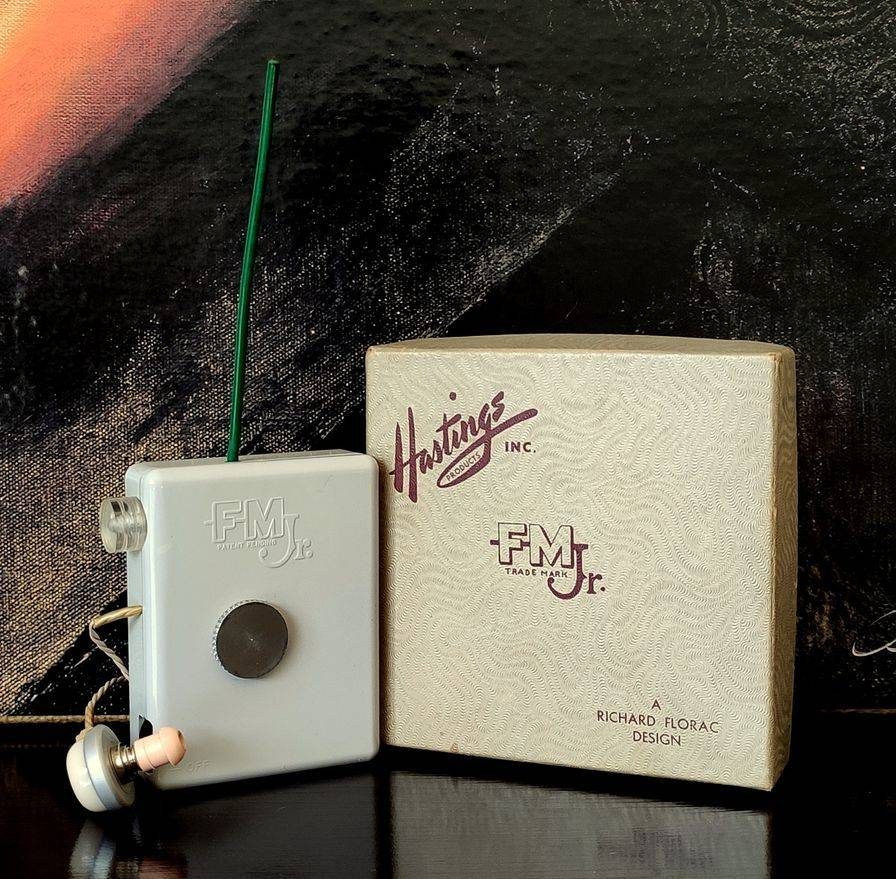
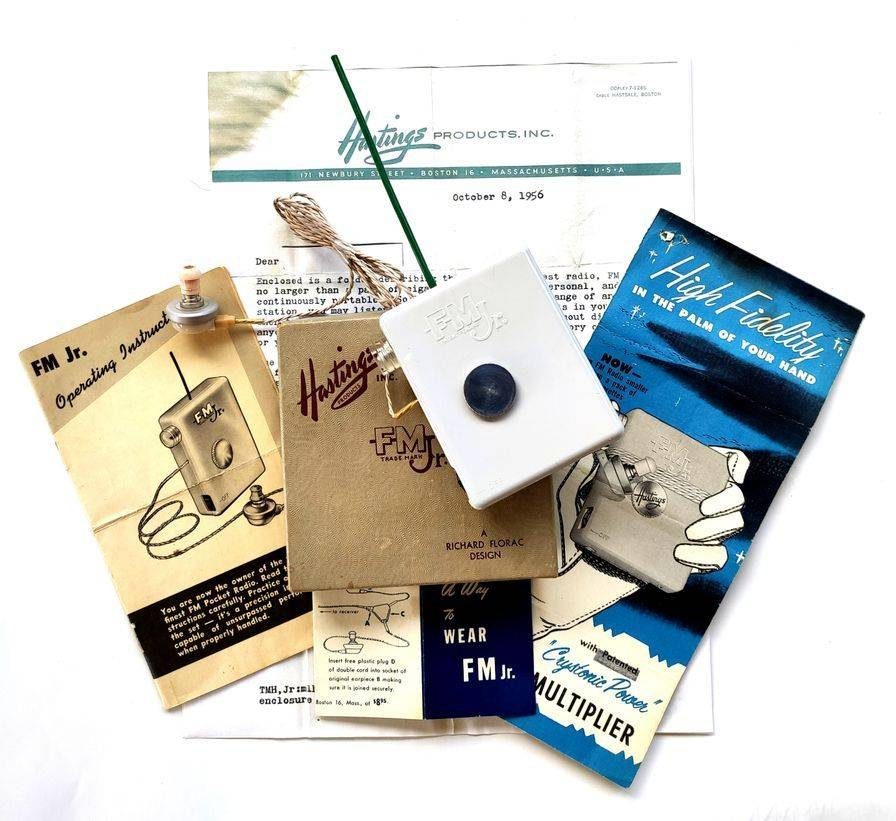
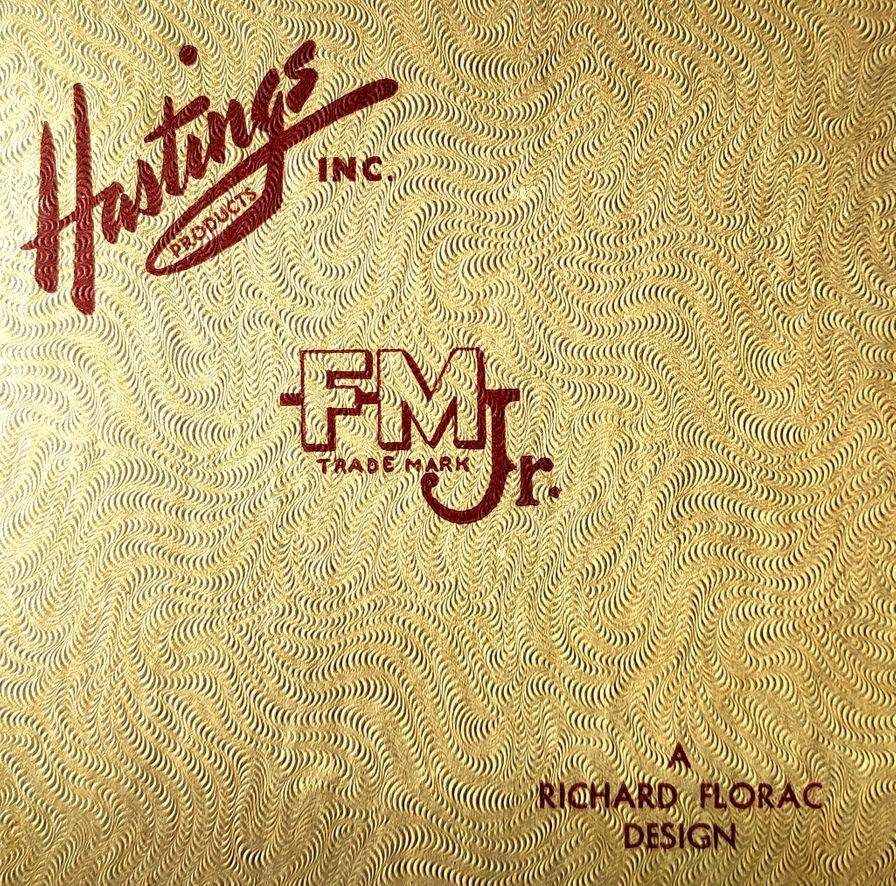

So, was the Hastings FM Jr the world’s first commercially available shirt pocket FM radio? I believe that it is possible, but I do not have enough information to say for sure. Schiffer states that «In 1950 Micro-Electronics offered the first shirt pocket FM receiver for $37.50» (Ref 1g). He does not give any more information. I believe that the company he is referring to is ‘Micro-Electronic Products Inc’ (who also manufactured hearing aids). In 1949 they offered a shirt pocket ‘micro-radio’ that operated on the standard broadcast band (an advertisement for this radio can be seen on my Privat-ear page). In 1950 they launched a shirt pocket FM radio called the Micronet. An article in the Kokomo Tribune (10th of November 1950) states — «The Micronet pocket radio was placed on the market Thursday for the use of Police, Firemen and other authorized agencies…. It will pick up Police, Fire, and mobile telephone calls and has been tested by the Los Angeles Police Department to a range of 60 miles».
This certainly doesn’t sound like a typical radio product that was available to the general public. A reference in Electronic Industries Magazine, Volume 10, 1951 describes the Micronet radio as covering the FM band and receiving television sound on channels 5 and 6. Schiffer gives a sale price of $37.50 which may have been the price it was sold to agencies for or perhaps it was made commercially available and I’ve simply been unable to locate this information. Although I have great respect for Schiffer, he was not always right and he did get some details wrong when he inferred that the FM Jr was released in 1958 and stated that it had «a telescoping antenna like the earlier Privat-ear» (Ref 1e). In Schiffer’s defence, in 1990, when he wrote ‘The Portable Radio in American Life’ he did not have access to a library of digitally archived newspapers as I do now and it can be difficult to get the small details right when you have limited information.
The Ekeradio to the left is the only rival to the FM Jr that I can find references to during the mid-fifties. It was sold in kit form as either a one tube FM set or using transistors. It was sold from 1954 until at least 1960. Prices ranged from around $9.95 (plus $5.95 for the earphone) for the single tube set in 1954 to $29.95 for the transistor kit as advertised in the ‘Fall 1960 edition of Radio — TV Experimenter’.
So perhaps the Hastings FM Jr was the world’s first commercially available shirt pocket FM receiver; there is some evidence for this being the case (or lack of evidence for it not being the case!) or maybe I’m simply missing something. Regardless, it does have its place in history and is certainly a unique little radio.
When examining its cabinet design, the FM Jr bears a closer resemblance to a 2018 MP3 Player than to popular transistor shirt pocket radios released years later (see group photo below). It is certainly far more modern looking than the earlier Privat-ear. When I first viewed this radio and learned that it was an FM shirt pocket radio from 1955 I was highly sceptical; I had never heard of such a thing and its appearance did not seem to me, to fit the time period. It was only after careful research that my uncertainty abated.
Even the brochure has a futuristic look to it; it looks like a feminine robot is delicately holding the FM Jr — with Crystonic Power!
The FM Jr has a simple, clean look. There is no reverse painting, no bold chevron, no bright colourful cabinet, just minimalist utilitarian design, functional and well made. The cabinet colour is described in the brochure as ‘French Grey’ — very chic! ‘FM Jr Patent Pending’ is embossed on the front along with ‘Off’. The single screw that holds the cabinet together is cleverly disguised as a fake button. In attached literature the ‘Hastings Products’ motif is displayed on this ‘button’ and in other pictures it is shown blank. On the few examples of this radio that I’ve seen there is no logo displayed this way.
The clear tuning dial, earphone and on/off volume control are all located on the same side.
The flexible green antenna protrudes from the top like an erect garden hose! I think it would look far better if this was black, as it was on the earlier Florac pager. On the back is a warning to turn off the volume control when not in use and a metal belt clip.
To the right you can see an illustration from the instruction manual — let me be clear, do not do this! Do not store your vintage radios with the earphone cord wrapped around them. Over time, the vinyl insulation covering the wires reacts with the plastic radio cabinet and causes nasty melt marks. I recommend wrapping the wires away from the radio when in storage….
This radio came to me with the original gift box, operating instructions, FM Jr brochure, additional instructions on how to wear the FM Jr, and what looks like a generic letter dated October 8, 1956 — signed by T. Mitchell Hastings Jr. On the back of the brochure is a stamp that states the radio was sold by ‘High Fidelity Service Laboratory’, 1114 — 18th Street, N. W. Washington 6, D. C. There is no purchase date.

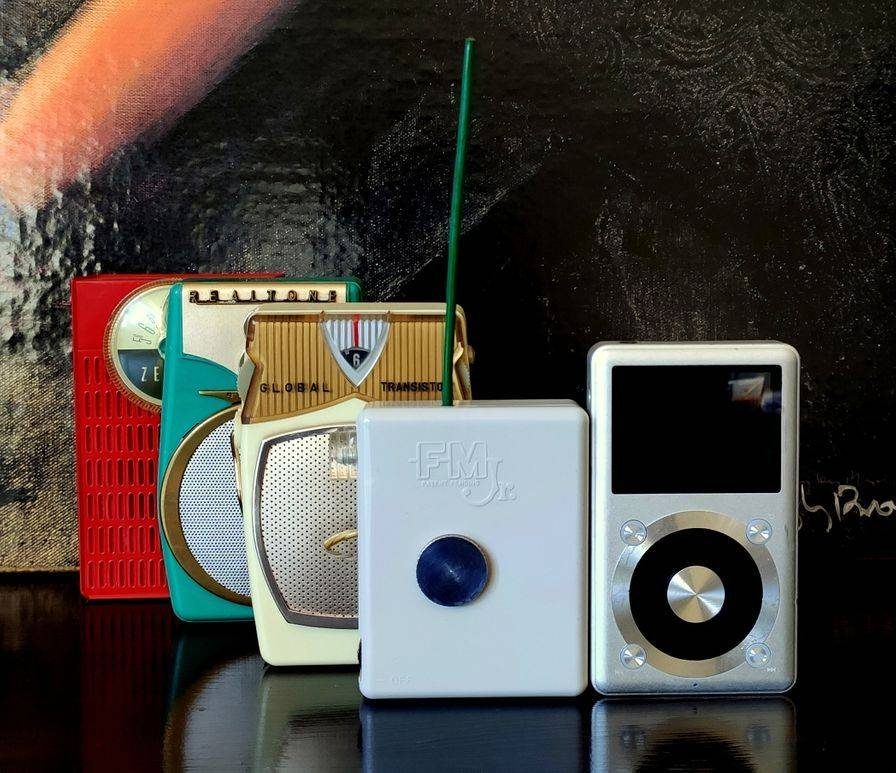
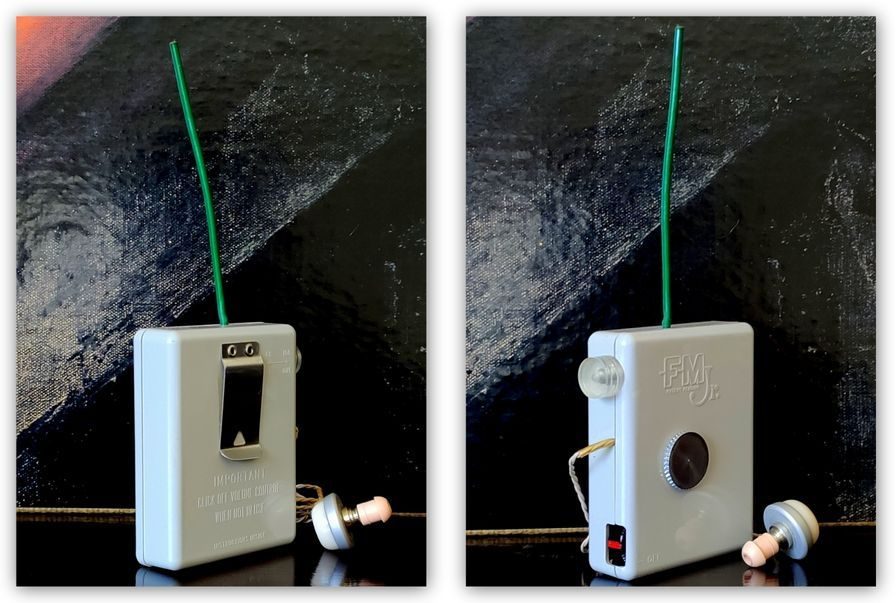

The advertisement below for the Hastings FM Jr appeared in the Greenville News, December 23rd 1955. It would have made a unique Christmas present for those annoying loved ones who are hard to buy for! This is the only ad for the FM Jr that I’ve been able to procure with attached picture. The latest advertisement I’ve seen for the FM Jr was in the 1957 edition of ‘Valley News’ (Van Nuys, California) where it was offered for sale for $15.95.
More from the 12 page instruction manual; this is a summary of the advantages of FM. The first five on the list are covered in depth, in the manual.
‘Old meets New’ — An interesting advertisement featuring the Regency TR-1 and Florac appeared in the Chicago Tribune on the 2nd of March 1955. This is a meeting of two technological marvels — the Florac using yesteryear’s miraculous subminature tubes and the TR-1 using transistors that were about to revolutionize the electronics industry! It is very cool to see them together.
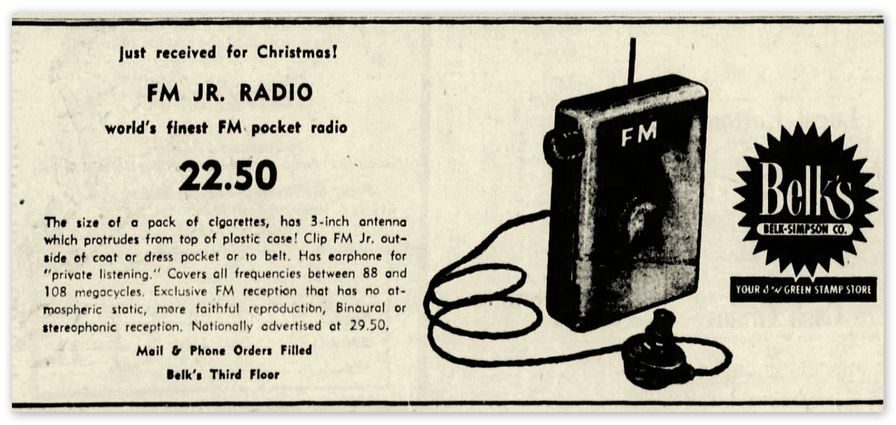
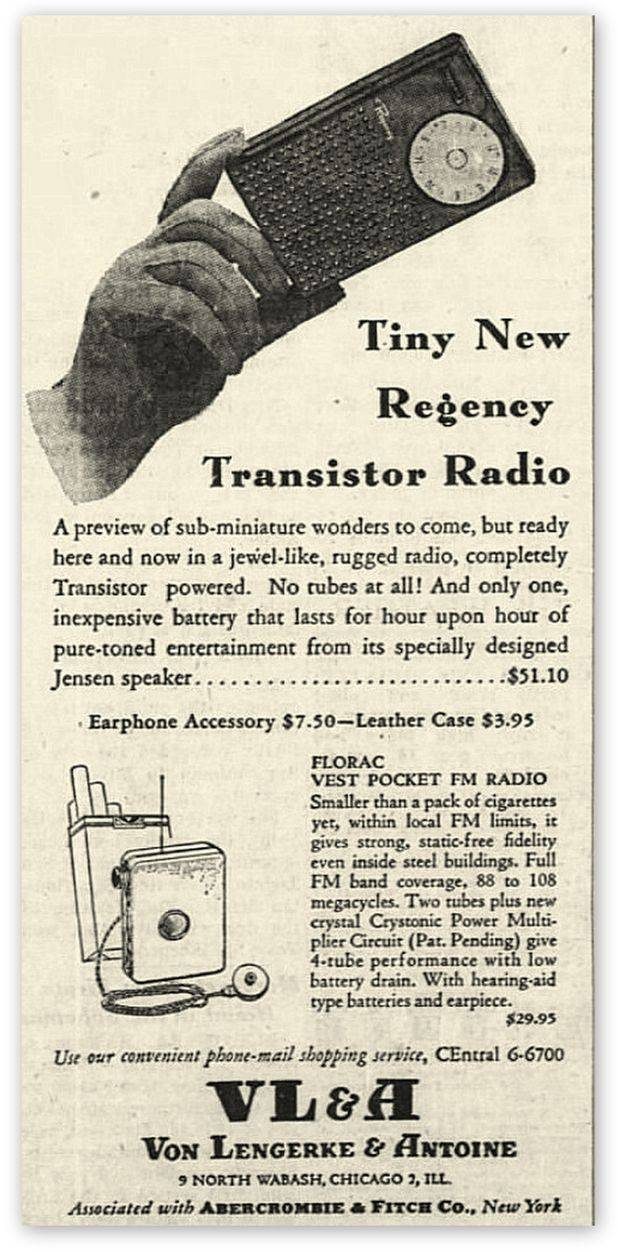
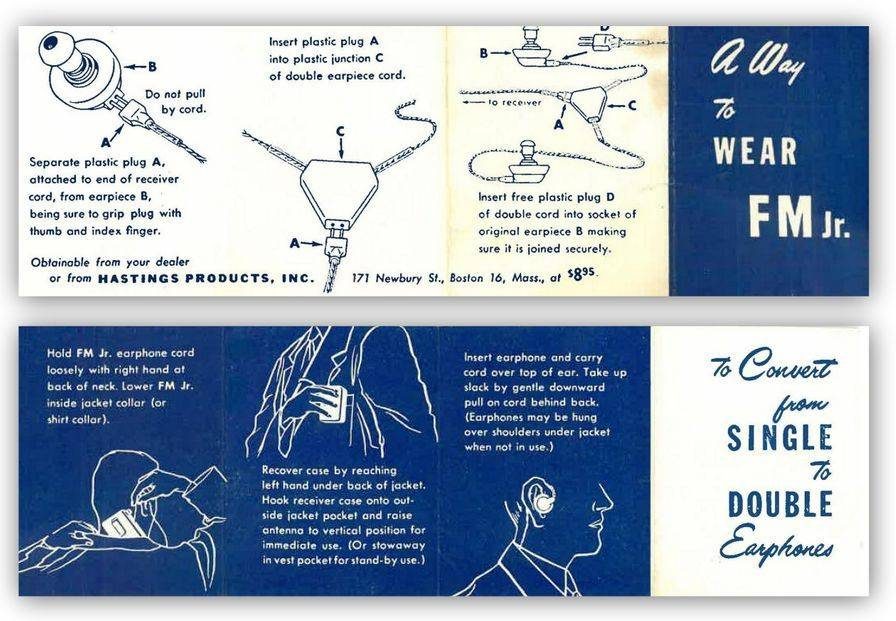
Below is the generic letter sent out by Hastings offering the FM Jr for the factory price of $19.95.
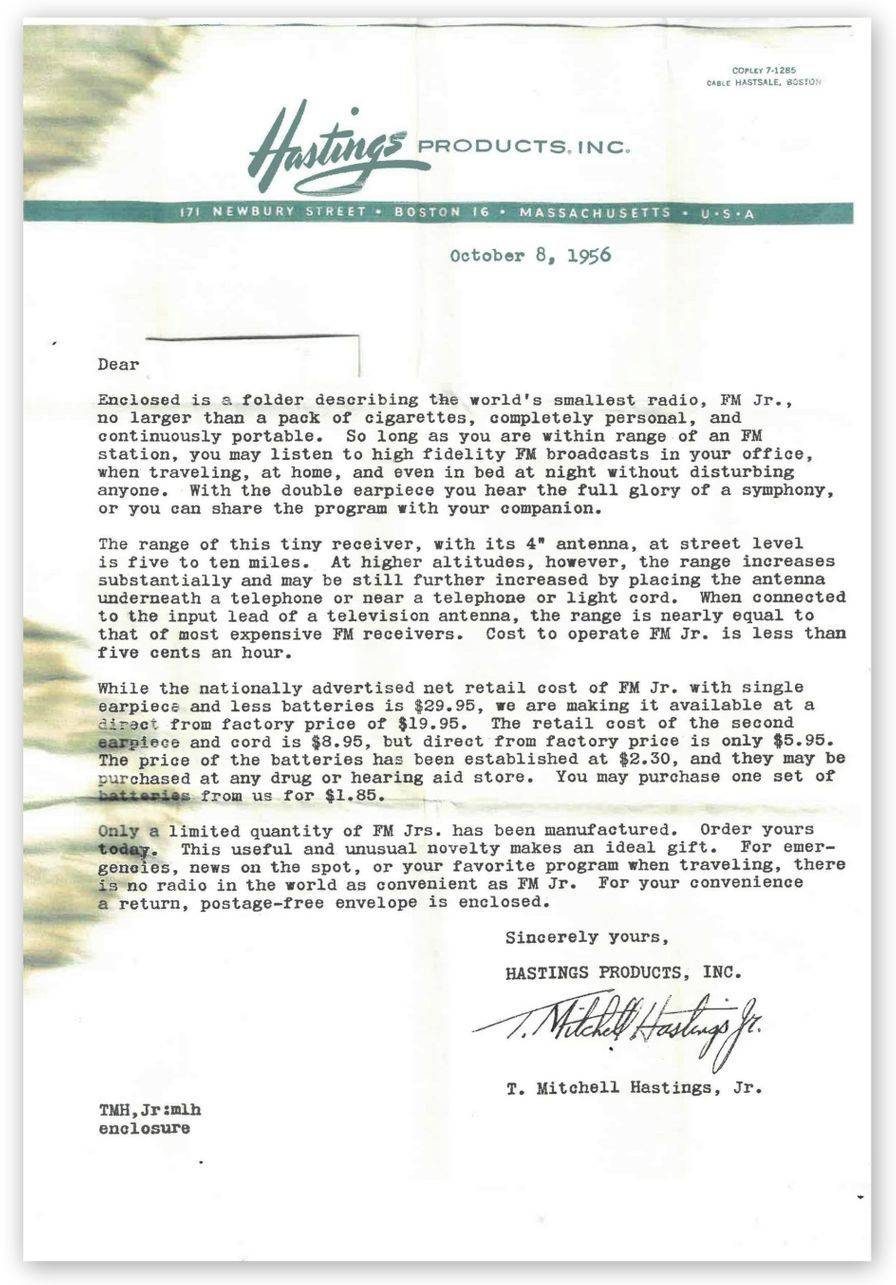

The Hastings FM Jr is a tuned radio frequency receiver (TRF) with regeneration. If you are technically minded, then I would recommend you read the superb article written by expert Joe Sousa about the circuit used in the FM Jr and how it relates to two key patents filed by Richard Florac. The article is hosted at Radio Museum and is titled ‘Hastings: FM Jr Super-Regeneration with Reduced Radiation’. You can see the two patents pictured below.
The FM Jr uses two subminiature tubes manufactured by Raytheon. These tubes were first developed by Raytheon between 1938 and 1941 for use in hearing aids and later for use in proximity fuse radars used in U.S mortar shells. The proximity fuse, one of the most closely guarded secrets of the war, could accurately detonate an artillery shell just above the ground, or an antiaircraft shell when it reached the vicinity of an enemy airplane. The tubes went through extensive development to allow them to withstand g-forces up to 20000 times normal gravity – as a result of being fired from an artillery piece (REF 1H). They’re exceedingly tough and will easily withstand a drop test from a height of three to four feet onto a tiled or concrete floor without breaking. Later, they were modified for use in the first Florac radio pager, portable radios like the Privat-ear and continued to be used in hearing aids before transistors became widely available.
The FM Jr uses two hearing aid aid batteries; a 1.4v Mallory RM-12 ‘A’ battery and a long 30v Eveready 507 ‘B’ battery.
Below is an interesting excerpt from the brochure, ‘The Inside Story of FM Jr’ along with pictured vintage ‘A’ and ‘B’ batteries.
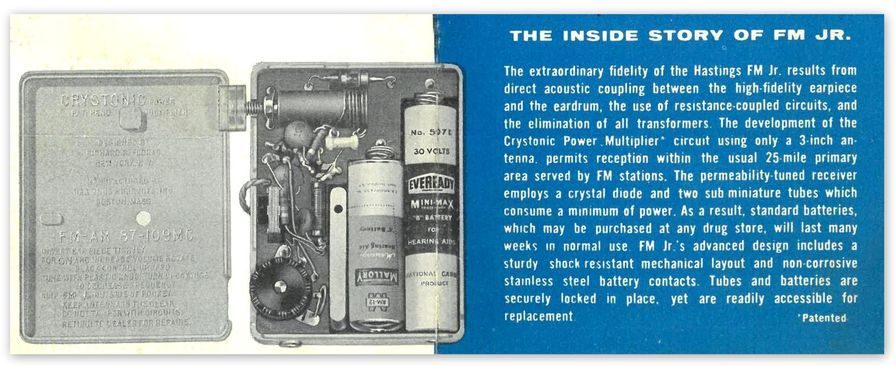
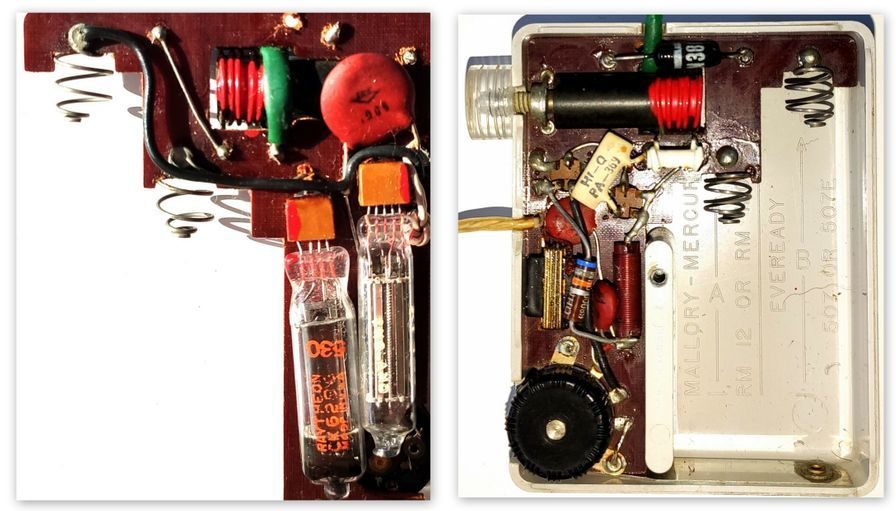

Patent number 2619589 below, filed in 1950, was the original patent for the Florac Radio Pager. It had an enclosed speaker and was designed to be held up to your ear like a mobile phone (time traveller!). It was from this patent and the patent below it (No 2799775 filed in 1955) that the Hastings FM Jr originated. If you look up these two patents you will find a very long description of each invention.
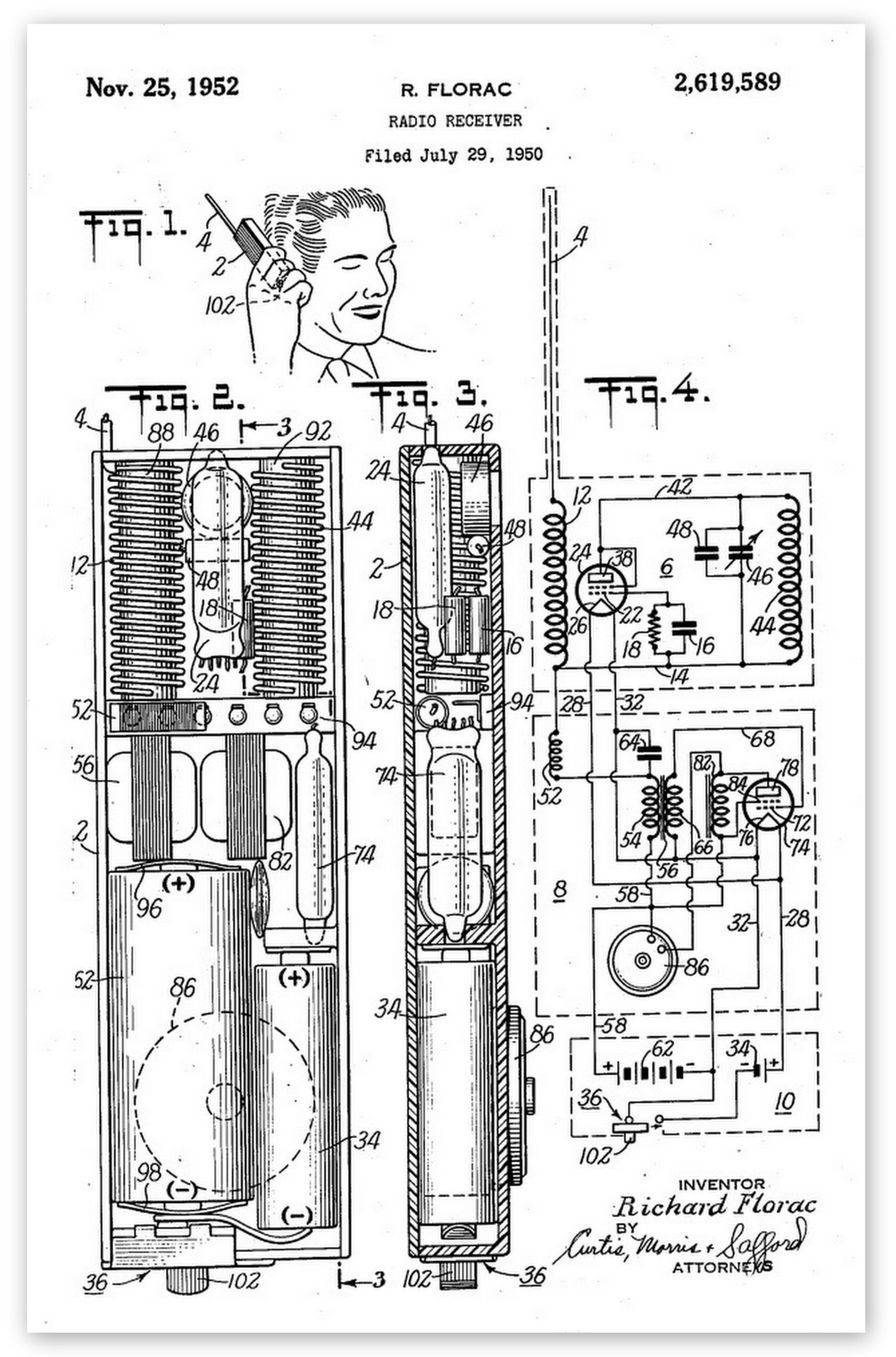
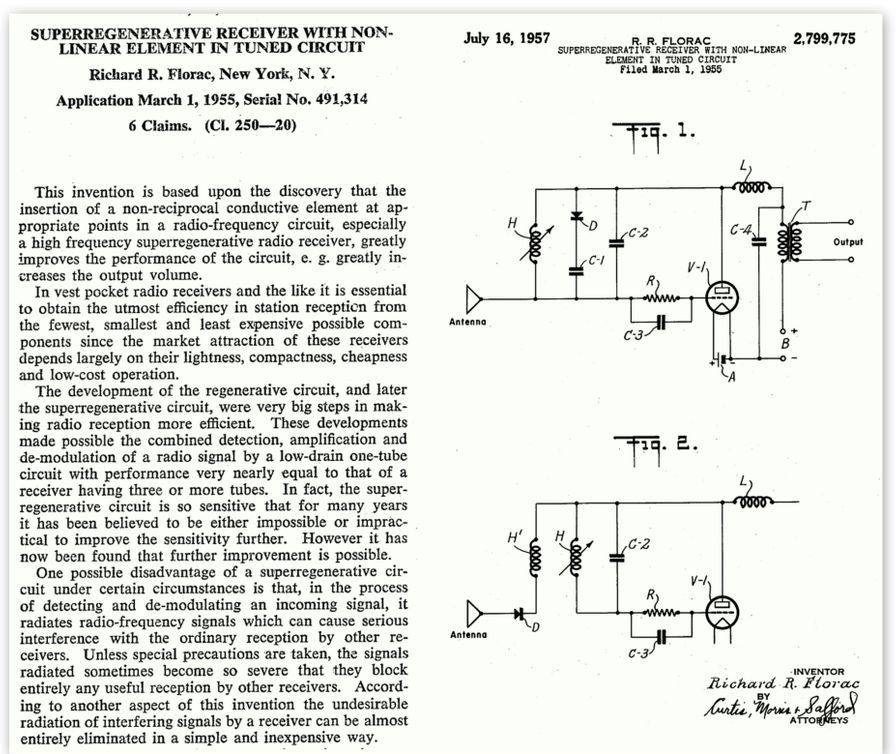
I better include a schematic diagram because if I don’t then somebody wont be happy!

I’m going to finish with a line from the brochure «Choose FM Jr and enjoy the most unique listening experience offered by the radio industry…. anywhere…. anytime».
REFERENCES
(1a) The South Bend Tribune 5th of September 1952
(1b) Reno Gazette-Journal 23rd February 1954
(1c) Hartford Courant 20th off November 1957
(1d) Sounds of Change: A History of FM Broadcasting in America
(1e) The Portable Radio in American Life (Page 195) – Michael Brian Schiffer
(1f) The Portable Radio in American Life (Page 169) – Michael Brian Schiffer
(1g) The Portable Radio in American Life (Page 166) – Michael Brian Schiffer
(1h) Raytheon Company: The First Sixty Years — Alan R. Earls & Edward E. Edwards